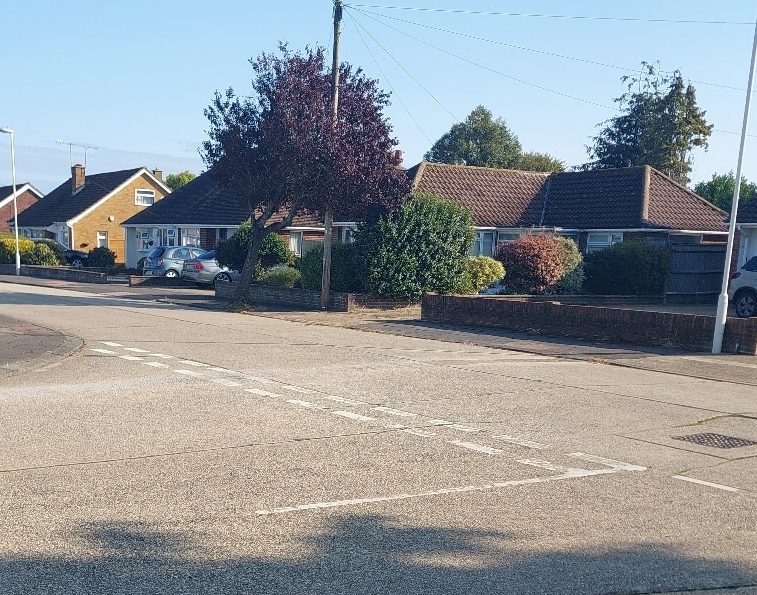
What is the Definition of an Emerging T Junction?
An emerging T junction is a type of junction where a minor road intersects with a major road at an angle, forming a T-shape. In this type of junction, the driver on the minor road must give way to traffic on the major road. The main purpose of an emerging T junction is to allow vehicles on the minor road to safely enter the flow of traffic on the major road without causing any disruptions or hazards.
What are the Key Features of an Emerging T Junction?
The key features of an emerging T junction include physical features, road markings and signs, and safety measures.
Road Markings and Signs:
- At an emerging T junction, there are certain road markings and signs that drivers should be aware of. These include give way signs and/or lines or stop signs and/or lines on the minor road, indicating where vehicles should stop and give way to traffic on the major road.
- Box junctions marked with criss-cross yellow lines may be present at the junction. Drivers must not enter the box until their exit road or lane is clear. At signalled roundabouts, drivers must not enter the box unless they can cross over it completely without stopping.
- Advanced stop lines may also be present at signal-controlled junctions. These allow cyclists to be positioned ahead of other traffic. Motorists must stop at the first white line reached if the lights are amber or red, and should avoid blocking the way or encroaching on the marked area at other times.
Safety Measures:
- Emerging T junctions are designed to ensure the safety of drivers and other road users.
- Drivers should use their mirrors to assess the position and movement of traffic before emerging at a T junction. They should also follow the MSPSL routine (Mirrors, Signal, Position, Speed, Look) when approaching the junction.
- The road markings and signs at an emerging T junction provide clear instructions to drivers, helping them navigate the junction safely.
- Drivers should exercise sound judgement of gaps in traffic to manoeuvre out of the junction safely and avoid causing other vehicles to change their speed or direction.
What are the Rules and Regulations for Emerging T Junctions?
Rules and Regulations for Emerging T Junctions
The Highway Code in the UK provides guidelines and regulations for drivers when approaching and emerging from T junctions. These rules are in place to ensure the safety of all road users and to maintain a smooth flow of traffic.
Tips and Techniques for Approaching & Emerging at T Junctions
Some tips and techniques for improving your skills in emerging from T junctions include:
- Mirror: Before emerging from a T junction, it is important to check your mirrors, including the interior and left/right door mirror, to assess the position and movement of traffic behind and to the side of you. This will help you determine when to slow down and whether it is safe to emerge.
- Signal: Once you have checked your mirrors, it is important to give a right/left-turn signal in good time to indicate your intention to turn right. Signalling in advance will alert other road users of your intention and help prevent potential collisions. However, be careful not to signal too early, as this can confuse other drivers.
- Position: When turning right at a T junction, you should take up a position just left of the middle of the road or in the space marked for traffic turning right. This positioning ensures that you have enough room to turn safely and that you are not blocking the way of other vehicles. On the other hand, when turning left, you should position your vehicle about a meter from the kerb or within the dedicated lane that may be marked.
- Speed: When apporaching and emerging from an open T junction, it is important to reduce your speed to roughly 10mph. This allows you to have better control of your vehicle and gives you enough time to assess the situation and make any necessary adjustments. At a closed junction you will need reduce your speed even more to be able to effectively see into the junction.
Look: Look in all directions before emerging from the T junction. Be vigilant for cyclists, motorcyclists, pedestrians, and other road users. Ensure that the way is clear before proceeding.
In addition to the MSPSL routine, some specific driving techniques and strategies that can help in emerging from T junctions include:
- Maintaining a steady speed when emerging from a T junction.
- Keeping your vehicle in the correct lane.
- Being aware of your surroundings and checking for any potential hazards.
- Anticipating the movements of other road users and adjusting your actions accordingly.
- Using your mirrors and blind spots to ensure there are no other vehicles in the vicinity before emerging.
- Being cautious of vehicles following closely behind and emerging on your left when slowing down, such as cyclists.
By following these tips, techniques, and driving strategies, you can improve your skills in emerging from T junctions and ensure a safe and efficient journey.
What the Highway Code says about Emerging T Junctions
The Highway Code provides specific rules and guidelines for emerging T junctions. These rules and guidelines are designed to ensure that drivers are aware of their responsibilities when approaching and navigating T junctions.
Legal Requirements
At emerging T junctions, drivers must obey the rules of the road and adhere to the legal requirements. This includes giving way to traffic on the main road, using the correct lane, and giving way to pedestrians. Drivers must also be aware of any speed limits and traffic signs that may be in place.
Right of Way
When approaching a T junction, drivers must give way to traffic on the main road. This means that drivers must slow down and wait for a gap in the traffic before entering the main road. Drivers must also be aware of any traffic signals or signs that may be in place.
Lane Use
When approaching a T junction, drivers must use the correct lanes. This means that drivers must use the designated left lane when turning left, and the designated right lane when turning right. Drivers must also be aware of any traffic signals or signs that may be in place.
Pedestrians
When approaching a T junction, drivers must give way to pedestrians. This includes being aware of any pedestrians that may be crossing the junction and giving them priority. Drivers must also be aware of any road markings or signs that indicate the presence of pedestrians.
Cyclists
When approaching a T junction, drivers must also give way to cyclists. This includes being aware of any cyclists that may be crossing the junction and giving them priority. Drivers must also be aware of any road markings or signs that indicate the presence of cyclists.
Road Markings and Signs
Drivers must also be aware of any road markings or signs that indicate the junction is a give way junction. This includes being aware of any broken white lines across the road, which indicate that drivers must give way to traffic on the main road. Drivers must also be aware of any stop signs or traffic lights that may be in place.
A thorough understanding of the Highway Code can help drivers safely navigate emerging T junctions. By understanding the rules and guidelines for emerging from T junctions, drivers can ensure that they are following the correct procedures and giving way to traffic on the main road. Drivers should also be aware of the legal requirements and obligations, such as giving way to pedestrians and cyclists. Additionally, drivers should be aware of any road markings or signs that indicate the junction is a give way junction. By being aware of these factors, drivers can make informed decisions and reduce the risk of accidents.
Expert Advice from Smart Drive UK on Emerging T Junctions and Driving
The experts at Smart Drive UK recommend that learner drivers take their time when emerging from T junctions. They emphasise the importance of applying the MSPSL routine in good time and being aware of the type of T junction being approached (open or closed). Learners should also be cautious of restricted views and can lean forward to increase visibility. Additionally, it is crucial to be vigilant for pedestrians and cyclists, as they can easily be missed.
Specific tips and insights from experienced driving instructors include:
- Blind T-junctions: When approaching a blind T-junction, it is advised not to force the car into first gear until the speed is less than 5mph and the learner is almost at the give way line. Clutch control may be necessary to “creep” forward slowly. If the vehicle moves too fast on the clutch, the clutch should be dipped to slow down and use the brake effectively.
When emerging from a T junction, learners should:
- Slow down and check for oncoming traffic on the major road.
- Look both ways before emerging.
- Ensure they are in the correct gear.
- Use mirrors and signals.
- Be aware of potential hazards.
The expertise of Smart Drive UK can help learners improve their skills in navigating T junctions through various means:
- Theory and practical driving lessons: Smart Drive UK offers comprehensive lessons that cover the necessary knowledge and practical skills for navigating T junctions safely and confidently.
- Online resources and videos: Learners can access a range of online resources and videos provided by Smart Drive UK to enhance their understanding of T junction navigation.
- Mock tests and assessments: Smart Drive UK offers mock tests and assessments to evaluate learners’ progress and identify areas for improvement specifically related to T junctions.
- One-to-one tuition: Learners can benefit from personalised one-to-one tuition with Smart Drive UK instructors, who can provide tailored advice and guidance on approaching T junctions.
- Refresher courses: Smart Drive UK offers refresher courses for learners who may need additional practice or reinforcement of their T junction navigation skills.
By taking advantage of the expertise of Smart Drive UK, learners can gain the confidence and skills they need to safely and confidently navigate T junctions. The guidance provided by Smart Drive UK instructors covers various aspects, including approaching T junctions, reading traffic signals and signs, and checking for oncoming traffic, mirrors, and blind spots.
Summary and Final Thoughts on Emerging T Junctions
Key Takeaways and Important Points to Remember about Emerging T Junctions
- Always use the MSPSL routine (Mirror, Signal, Position, Speed, Look) when approaching a T junction. This includes checking mirrors and blind spots, signalling in advance, adjusting position on the road, reducing speed, and making observations.
- Reduce speed to roughly 10mph and select 2nd gear when approaching an open T junction. For closed or blind T junctions, gradually reduce speed and select 1st gear when approximately 2 cars away from the give way line.
- Be aware of cyclists and pedestrians around the T junction. Wait behind the give way lines until it is clear.
- Lean forward slightly to improve visibility if visibility is restricted.
Contribution to Overall Driving Skills and Safety
Having a thorough understanding of emerging T junctions is essential for safe driving. By being aware of the different types of T junctions and the correct procedures for emerging from them, drivers can navigate these junctions confidently and safely. The use of the MSPSL routine and clutch control techniques can help drivers make informed decisions and respond appropriately to the traffic conditions at T junctions.
By checking mirrors and blind spots, adjusting speed, and being aware of other vehicles and pedestrians, drivers can reduce the risk of accidents and ensure a safe journey. Understanding the speed limit and adjusting speed accordingly is also crucial for maintaining safety on the road.
Additional Resources and Support from Smart Drive UK
Smart Drive UK offers a range of resources and support for learners seeking further guidance on emerging T junctions. These resources include online tutorials, videos, and practice tests. Learners can access these materials to enhance their understanding of emerging T junctions and other driving skills.
In addition to the online resources, Smart Drive UK also provides courses and workshops that focus on emerging T junctions and other important driving skills. These courses offer learners the opportunity to gain practical experience and receive personalised instruction to improve their driving skills and safety.
Overall, a thorough understanding of emerging T junctions is crucial for safe driving. By following the correct procedures, being aware of potential hazards, and utilising the resources and support available, learners can enhance their driving skills and contribute to a safer road environment.
How can learners get in touch with Smart Drive UK for personalised guidance and support on emerging T junctions?
Learners in the UK can easily get in touch with Smart Drive UK for personalised guidance and support on emerging T junctions. They can contact Smart Drive UK by either calling their phone number or filling out the contact form on their website. The contact information is readily available on their website, making it convenient for learners to reach out and seek assistance.
What services does Smart Drive UK offer to help learners improve their skills in navigating T junctions?
Smart Drive UK offers a comprehensive range of services to help learners improve their skills in navigating T junctions. They provide one-on-one driving lessons with experienced instructors who are highly qualified and have years of experience in teaching learners how to navigate T junctions safely and effectively. These driving lessons are tailored to the individual needs of each learner, ensuring personalised guidance and support.
In addition to driving lessons, Smart Drive UK also offers online tutorials and practice tests. These resources are designed to help learners prepare for their practical driving test and enhance their understanding of emerging T junctions. The online tutorials provide step-by-step guidance and explanations, while the practice tests allow learners to assess their knowledge and skills in a simulated environment.
Why should learners choose Smart Drive UK as their trusted partner in mastering emerging T junctions?
There are several reasons why learners should choose Smart Drive UK as their trusted partner in mastering emerging T junctions. Firstly, Smart Drive UK has a team of experienced instructors who are highly qualified and have extensive experience in teaching learners how to navigate T junctions. Their expertise and knowledge ensure that learners receive accurate and reliable guidance.
Secondly, Smart Drive UK offers personalised guidance and support. Their one-on-one driving lessons are tailored to the individual needs of each learner, allowing for a customised learning experience. This personalised approach ensures that learners receive the specific guidance and support they require to master emerging T junctions.
Furthermore, Smart Drive UK provides a range of online resources, including tutorials and practice tests. These resources are designed to be user-friendly and easy to understand, allowing learners to make the most out of their learning experience. The combination of in-person driving lessons and online resources provides a comprehensive and well-rounded approach to learning how to navigate T junctions.
Overall, learners should choose Smart Drive UK as their trusted partner in mastering emerging T junctions because of their experienced instructors, personalised guidance and support, and comprehensive range of services. Smart Drive UK is committed to helping learners become confident and safe drivers, making them an ideal choice for UK learner drivers seeking expert guidance on emerging T junctions.


